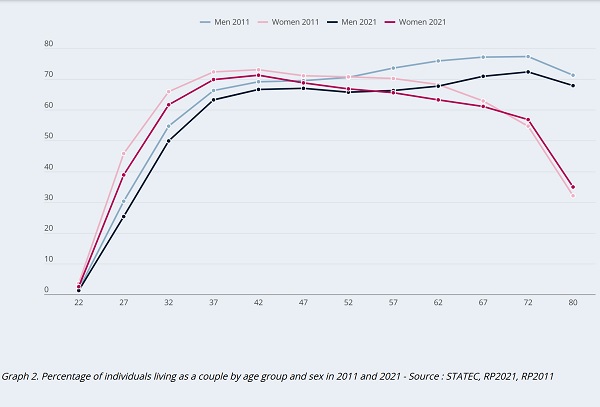 Credit: STATEC, , RP2021, RP2011
Credit: STATEC, , RP2021, RP2011
Luxembourg's statistical institute, STATEC, recently published a report providing an overview of households and family types in the Grand Duchy, using data taken from the 2021 population census.
In 2021, most residents in Luxembourg (643,941 people) lived either in private households (632,610) or in collective households (11,331). Collective households represent a wide variety of lifestyles and living arrangements. More than half of people living in collective households were over the age of 65, three-quarters of whom were women. These were mostly residents in retirement or nursing homes for the elderly.
Moreover, the 2021 census data confirmed that the majority type of household was based on couples (regardless of legal status), with or without children, accounting for 63.1% of households. Between 2011 and 2021, the most significant growth was seen in couples without children (whose share increased by +2.1 percentage points). The rise in single-parent families (+1.9 percentage points), formed by so-called "isolated" mothers or fathers, is also notable. While women were overwhelmingly the majority in single-parent families in 2011, there has been a partial rebalancing between men and women, which may be attributed to the complex decisions around child residency in cases of shared custody, according to STATEC.
Over ten years, the population of individuals living in a household where the reference person was a native of Luxembourgremained stable, with a slight decline of 0.2%. In contrast, the population of individuals living in a household where the reference person was born outside Luxembourg saw significant growth, increasing by 55.2%. Households where the reference person was born abroad were more often couples with children (51.2% compared to 43.0% for native households). Conversely, households where the reference person was born in Luxembourg were more often couples without children, or single mothers.
Similarly, the average number of children per household was higher in households where the reference person was born abroad. Native households, on the other hand, tend to have fewer children, according to the statistics.
STATEC noted that the diversification of household models is more clearly observed across age groups. Firstly, individuals are forming couples later in life: for men and women aged 25 to 34, the percentage of people living as a couple has declined by nearly 5 percentage points, reflecting a delay in couple formation of nearly one year. In the 40 to 49 age group, the rate of living as a couple has decreased by around 2 percentage points. The impact of higher male mortality means that there are fewer widowers than widows: men thus have a higher likelihood than women of remaining in a couple until the end of life. However, between 2011 and 2021, this relative advantage of men in terms of remaining in a couple into old age diminished. After the age of 75, more women were living in a couple in 2021 compared to 2011, as they become widows later in life.
When examining the legal forms, the data revealed a clear diversification of marital models chosen by couples, especially among younger generations. Among those aged 30 to 34, 56.1% of couples were married. Compared to 75.1% in 2011, this represents a rapid decline in marriage in favour of registered partnerships and cohabitation. This profile of young adults contrasts with that of individuals over the age of 60, where more than 90% of couples were married.
Regarding the number of children per household, the curve peaks between the ages of 40 and 44, corresponding to the period when the youngest children are born while the older ones have not yet left the household. Married couples were found to have the highest number of children on average compared to cohabiting couples, with individuals in registered partnerships falling between the two.
Another aspect of diversification appeared in the composition of couples by country of birth. Younger age groups included more couples where both members were born abroad. Conversely, among those aged over 70, native couples were the majority, whereas they made up only a quarter of couples under 50. Moreover, households where the reference person was born abroad were more often couples with children. In contrast, households where the reference person was born in Luxembourg were more frequently single individuals, couples without children, or single mothers. Overall, in 2021, households with children were more prevalent among immigrants.
Looking at same-sex couples, STATEC reported that changes in the legal framework (notably the 2004 law recognising civil unions, particularly for same-sex couples, and especially the 2014 law allowing same-sex couples to marry) have also contributed to the diversification of family models. Although comparisons over time may be delicate, the 2021 census recorded 3,300 people living in same-sex couples, compared to 826 in 2011. This represents a threefold increase in their proportion within the population of couples compared to 2011. This trend confirms that, in Luxembourg as in other European countries, same-sex couples now enjoy greater recognition through censuses.
STATEC later added that there was a marked territorial distribution of couples with at least one child under the age of 25. In 2021, only 18.8% of such families lived in Luxembourg City. By contrast, other municipalities on the outskirts of the urban area of Luxembourg, such as Betzdorf, Flaxweiler and Manternach, all had more than 38% of such families. Economic factors (e.g. cost per square metre) and urban planning preferences (e.g. a preference for intermediate densities) may explain this specific distribution of families. In contrast, the living arrangements of single individuals and couples without children were more compatible with residing in Luxembourg City.








